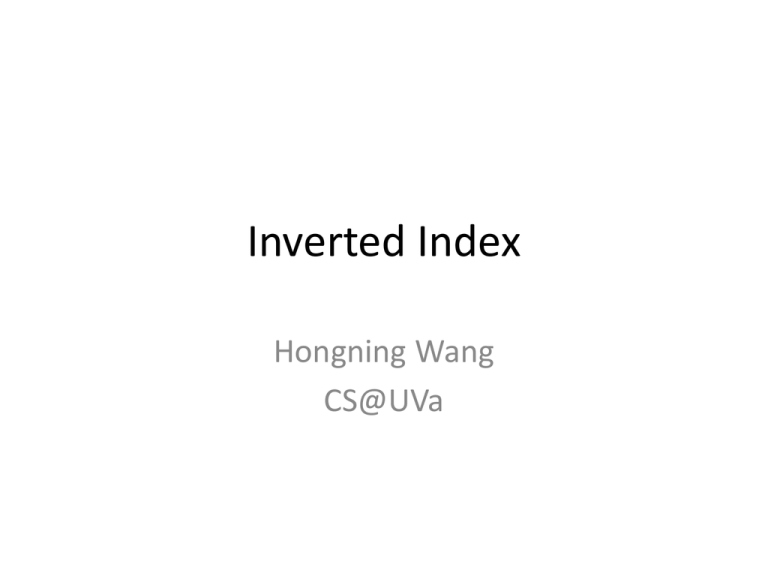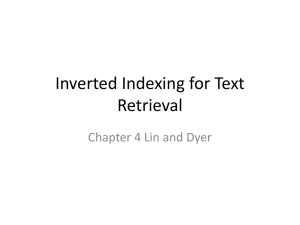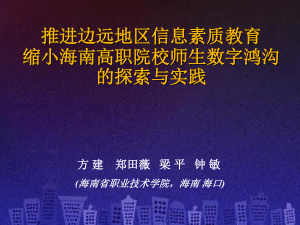Inverted Index
advertisement

Inverted Index
Hongning Wang
CS@UVa
Abstraction of search engine architecture
Indexed corpus
Crawler
Ranking procedure
Feedback
Doc Analyzer
Doc Representation
Indexer
CS@UVa
(Query)
Query Rep
Index
Ranker
CS6501: Information Retrieval
Evaluation
User
results
2
What we have now
• Documents have been
– Crawled from Web
– Tokenized/normalized
– Represented as Bag-of-Words
• Let’s do search!
– Query: “information retrieval”
information
retrieval
retrieved
is
helpful
for
you
everyone
Doc1
1
1
0
1
1
1
0
1
Doc2
1
0
1
1
1
1
1
0
CS@UVa
CS6501: Information Retrieval
3
Complexity analysis
• Space complexity analysis
– 𝑂(𝐷 ∗ 𝑉)
• D is total number of documents and V is vocabulary size
– Zipf’s law: each document only has about 10% of
vocabulary observed in it
• 90% of space is wasted!
– Space efficiency can be greatly improved by only
storing the occurred words
Solution: linked list for each document
CS@UVa
CS6501: Information Retrieval
4
Complexity analysis
• Time complexity analysis
– 𝑂( 𝑞 ∗ 𝐷 ∗ |𝐷|)
• 𝑞 is the length of query, |𝐷| is the length of a document
CS@UVa
doclist = []
for (wi in q) {
Bottleneck, since most
for (d in D) {
of them won’t match!
for (wj in d) {
if (wi == wj) {
doclist += [d];
break;
}
}
}
}
return doclist; CS6501: Information Retrieval
5
Solution: inverted index
• Build a look-up table for each word in
vocabulary
– From word to find documents!
Dictionary
Query:
information
retrieval
information
Doc1
retrieval
Doc1
retrieved
Doc2
is
Doc1
Doc2
helpful
Doc1
Doc2
for
Doc1
Doc2
Doc2
you
CS@UVa
Postings
everyone
Doc1
Doc2
CS6501: Information Retrieval
Time complexity:
• 𝑂( 𝑞 ∗ |𝐿|), |𝐿| is the
average length of
posting list
• By Zipf’s law, 𝐿 ≪ 𝐷
6
Structures for inverted index
• Dictionary: modest size
– Needs fast random access
– Stay in memory
• Hash table, B-tree, trie, …
• Postings: huge
“Key data structure underlying
modern IR”
- Christopher D. Manning
– Sequential access is expected
– Stay on disk
– Contain docID, term freq, term position, …
– Compression is needed
CS@UVa
CS6501: Information Retrieval
7
Sorting-based inverted index construction
Sort by docId
doc1
<1,1,3>
<1,2,2>
<2,1,2>
<2,4,3>
...
<1,5,3>
<1,6,2>
…
<1,1,3>
<1,2,2>
<1,5,2>
<1,6,3>
...
<1,300,3>
<2,1,2>
…
...
doc2
<1,1,3>
<2,1,2>
<3,1,1>
...
<1,2,2>
<3,2,3>
<4,2,5>
…
<Tuple>: <termID, docID, count>
Sort by termId
All info about term 1
doc300
CS@UVa
Term
Lexicon:
1 the
2 cold
3 days
4a
...
DocID
Lexicon:
<1,300,3>
<3,300,1>
...
Parse & Count
<1,299,3>
<1,300,1>
...
<5000,299,1>
<5000,300,1>
...
“Local”
sort
Merge sort
CS6501: Information Retrieval
1 doc1
2 doc2
3 doc3
...
8
Sorting-based inverted index
• Challenges
– Document size exceeds memory limit
• Key steps
– Local sort: sort by termID
• For later global merge sort
– Global merge sort
Can index large corpus
with a single machine!
Also suitable for
MapReduce!
• Preserve docID order: for later posting list join
CS@UVa
CS6501: Information Retrieval
9
A second look at inverted index
Approximate search:
e.g., misspelled queries,
wildcard queries
Dictionary
CS@UVa
Proximity search:
e.g., phrase queries
Postings
information
Doc1
Doc2
retrieval
Doc1
retrieved
Doc2
is
Doc1
Doc2
helpful
Doc1
Doc2
for
Doc2
you
Doc1
Doc2
everyone
Doc1
Dynamic index update
CS6501: Information Retrieval
Index compression
10
Dynamic index update
• Periodically rebuild the index
– Acceptable if change is small over time and
penalty of missing new documents is negligible
• Auxiliary index
– Keep index for new documents in memory
– Merge to index when size exceeds threshold
• Increase I/O operation
• Solution: multiple auxiliary indices on disk, logarithmic
merging
CS@UVa
CS6501: Information Retrieval
11
Index compression
• Benefits
– Save storage space
– Increase cache efficiency
– Improve disk-memory transfer rate
• Target
– Postings file
CS@UVa
CS6501: Information Retrieval
12
Index compression
• Observation of posting files
– Instead of storing docID in posting, we store gap
between docIDs, since they are ordered
– Zipf’s law again:
• The more frequent a word is, the smaller the gaps are
• The less frequent a word is, the shorter the posting list
is
– Heavily biased distribution gives us great
opportunity of compression!
Information theory: entropy measures compression difficulty.
CS@UVa
CS6501: Information Retrieval
13
Index compression
• Solution
– Fewer bits to encode small (high frequency)
integers
– Variable-length coding
• Unary: x1 is coded as x-1 bits of 1 followed by 0, e.g.,
3=> 110; 5=>11110
• -code: x=> unary code for 1+log x followed by
uniform code for x-2 log x in log x bits, e.g., 3=>101,
5=>11001
• -code: same as -code ,but replace the unary prefix
with -code. E.g., 3=>1001, 5=>10101
CS@UVa
CS6501: Information Retrieval
14
Index compression
• Example
Table 1: Index and dictionary compression for Reuters-RCV1.
(Manning et al. Introduction to Information Retrieval)
Data structure
Size (MB)
Text collection
960.0
dictionary
11.2
Postings, uncompressed
400.0
Postings -coded
101.0
Compression rate: (101+11.2)/960 = 11.7%
CS@UVa
CS6501: Information Retrieval
15
Search within in inverted index
• Query processing
– Parse query syntax
• E.g., Barack AND Obama, orange OR apple
– Perform the same processing procedures as on
documents to the input query
• Tokenization->normalization->stemming->stopwords
removal
CS@UVa
CS6501: Information Retrieval
16
Search within in inverted index
• Procedures
– Lookup query term in the dictionary
– Retrieve the posting lists
– Operation
• AND: intersect the posting lists
• OR: union the posting list
• NOT: diff the posting list
CS@UVa
CS6501: Information Retrieval
17
Search within in inverted index
• Example: AND operation
scan the postings
Term1
2
4
8
16
Term2
1
2
3
5
32
8
64
13
128
21
34
Time complexity: 𝑂( 𝐿1 + |𝐿2 |)
Trick for speed-up: when performing multi-way
join, starts from lowest frequency term to highest
frequency ones
CS@UVa
CS6501: Information Retrieval
18
Phrase query
• “computer science”
– “He uses his computer to study science problems”
is not a match!
– We need the phase to be exactly matched in
documents
– N-grams generally does not work for this
• Large dictionary size, how to break long phrase into Ngrams?
– We need term positions in documents
• We can store them in inverted index
CS@UVa
CS6501: Information Retrieval
19
Phrase query
• Generalized postings matching
– Equality condition check with requirement of
position pattern between two query terms
• e.g., T2.pos-T1.pos = 1 (T1 must be immediately before
T2 in any matched document)
– Proximity query: |T2.pos-T1.pos| ≤ k
scan the postings
CS@UVa
Term1
2
4
8
16
Term2
1
2
3
5
32
8
CS6501: Information Retrieval
64
13
128
21
34
20
More and more things are put into index
• Document structure
– Title, abstract, body, bullets, anchor
• Entity annotation
– Being part of a person’s name, location’s name
CS@UVa
CS6501: Information Retrieval
21
Spelling correction
• Tolerate the misspelled queries
– “barck obama” -> “barack obama”
• Principles
– Of various alternative correct spellings of a
misspelled query, choose the nearest one
– Of various alternative correct spellings of a
misspelled query, choose the most common one
CS@UVa
CS6501: Information Retrieval
22
Spelling correction
• Proximity between query terms
– Edit distance
• Minimum number of edit operations required to
transform one string to another
• Insert, delete, replace
• Tricks for speed-up
– Fix prefix length (error does not happen on the first letter)
– Build character-level inverted index, e.g., for length 3
characters
– Consider the layout of a keyboard
» E.g., ‘u’ is more likely to be typed as ‘y’ instead of ‘z’
CS@UVa
CS6501: Information Retrieval
23
Spelling correction
• Proximity between query terms
– Query context
• “flew form Heathrow” -> “flew from Heathrow”
– Solution
• Enumerate alternatives for all the query terms
• Heuristics must be applied to reduce the search space
CS@UVa
CS6501: Information Retrieval
24
Spelling correction
• Proximity between query terms
– Phonetic similarity
• “herman” -> “Hermann”
– Solution
• Phonetic hashing – similar-sounding terms hash to the
same value
CS@UVa
CS6501: Information Retrieval
25
What you should know
• Inverted index for modern information
retrieval
– Sorting-based index construction
– Index compression
• Search in inverted index
– Phrase query
– Query spelling correction
CS@UVa
CS6501: Information Retrieval
26





